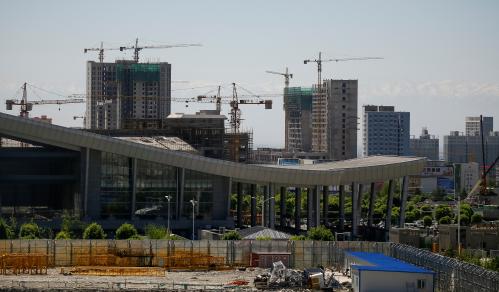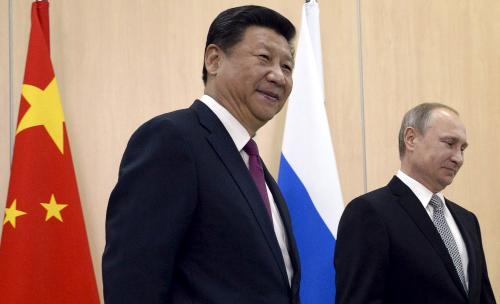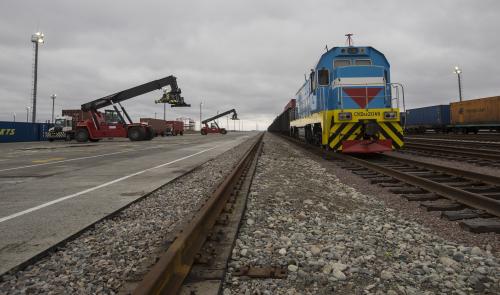The middle of nowhere actually exists. If you look for the place that is furthest away from any ocean in the entire world, you will find yourself in in North-Western China close to Khorgos, which also happens to be the main border crossing between China and Kazakhstan. In the past there was nothing there, just flat grassland and hardly anyone on both sides of the border, especially in Kazakhstan which is the largest landlocked country in the world and sparsely populated. Most of its 17.5 million inhabitants live in urban agglomerations, most notably Almaty, Astana, and Karaganda.
Figure 1: Kazakhstan: A natural transit corridor between East and West
 The map illustrates economic density; it has been adapted from Central Asia Development in 3-D
The map illustrates economic density; it has been adapted from Central Asia Development in 3-D
Today, however, a major transformation is underway. Khorgos has become the symbol of a concerted effort, spearheaded by China, to revive the old “Silk Road” connecting China with Europe through Central Asia.
Three economic trends motivate China’s orientation towards Central Asia:
- Production costs. As coastal China is becoming wealthier, manufacturing is moving inland, as well as to the Western provinces bordering Central Asia.
- Technological change. It will be difficult to substantially reduce the cost of air travel or to increase the speed of sea shipments. By contrast, there is still considerable scope to do both for rail and road transport; especially once new technologies—such as driverless cars, trucks, and trains—make it easier to operate a vehicle for 24 hours a day.
- Opportunity costs. As China produces higher value goods—think of computers instead of T-shirts—the opportunity cost of delays also rises. For these new goods, land transport is the most viable option because it is cheaper than air and substantially faster than sea. Today, a container transported from a Chinese port to Germany takes around 40 days by boat compared to 16 days by rail, and it is possible that overland transport will soon take as little as 10 days. Shipments by sea are still around half the price compared to overland transport, but this differential is becoming less significant if you factor in the opportunity costs.
There is a catch to the story though. Road transport has one major disadvantage relative to sea or air travel in that it involves crossing borders. This is an area where Kazakhstan still must improve significantly. It will only reap the benefits of the New Silk Road if it establishes efficient transport networks, modern logistics systems, and seamless border crossings, including in Khorgos.
While Kazakhstan has performed well in “Doing Business” (rank 41) overall, its performance in “trading across borders” (rank 122) is weak. It needs to cut red tape, including eliminating a special requirement for importing electronic equipment, which traders refer to as “KGB license.” In addition, a modern risk management system would allow low-risk goods and approved operators to enjoy faster and leaner procedures along a “green channel.” Such improvements would eventually lead to the establishment of a “single window,” which would fully automate the trading regime of Kazakhstan.
At Khorgos efforts are underway to address these challenges and to keep the Silk Road revival dream alive. Khorgos is a natural connection point because it is the place at which the two railway lines meet with different gauges so that containers need to be loaded from Chinese to Kazakh rail (and vice versa). And the dry port, which has cranes to quickly transfer containers from one train to the other, opened in the summer of 2015.
Building on this transport infrastructure, the governments have also put facilities in place to allow for visa-free border crossings between the two countries, which in turn could generate additional economic activities. A free trade area was also established, providing Kazakh consumers with shopping opportunities on the Chinese side of the border where stores are fully stocked with household items, clothing, and electronics. According to local sources, Kazakh citizens can spend up to $1,000 per visit, at duty-free wholesale prices, on goods that can be brought back by passenger train to Almaty, the largest city in Kazakhstan, and sold there at a good profit. Since the border point was opened in December 2011, the number of people crossing into China and back has grown to about 1,000 per day. Although Chinese citizens may also legally cross into Kazakhstan without a visa, few do and the Kazakh side of the border remains devoid of even a place to buy water or a snack.
The middle of nowhere is not where you would expect a successful economic hub to flourish. Investments in Khorgos, which have come entirely from state coffers, have been controversial. Detractors say that subsidies from both governments have only managed to create an artificial hub, and that the free economic zone amounts to an empty desert near the train tracks. Yet the Kazakh government plans to build housing for 100,000 people, who are expected to gain employment from the project. The hope is that Chinese producers (and other investors) will take advantage of Kazakhstan’s membership in the Eurasian Economic Union to set up assembly plants across the border and enjoy tariff-free sales within the union. According to the managers of the zone, 12 of the 74 applications were accepted, which was based on the criterion that investments should bring “new technology” to the Kazakh economy.
Ultimately, the success of Khorgos does not hinge on how many buildings, factories, or monuments are erected. In development, the intangible drivers of economic success are human. If Khorgos becomes a seamless border where goods, services, and people flow freely, then the dream will live.







Commentary
How the middle of nowhere could become a major trade corridor
September 23, 2016